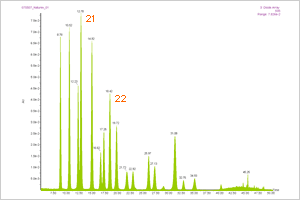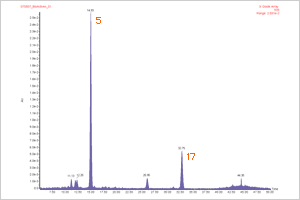
![]()
- It has scientific evidences with clinical data.
- ● Eye fatigue-related symptoms improvement [1] 160 mg/day
- ● Eye fatigue-related symptoms improvement [2] 120 mg/day
- It is extracted from bilberry that contains anthocyanin in an abundance, the (physiological) active components.
- It has a reliable quality with an accurate reproduction of anthocyanin profiles.
- It uses only 100% high quality bilberry fruits native to Scandinavia that have been guaranteed by the “Certificates of Origin”
- Domestic production for safe and secure quality. One and only in Japan!
It is the Health Food GMP (Good Manufacturing Practice) approved. - It is the bilberry extract that has been authenticated as both HALAL and KOSHER food.
- It complies with the system of “Food with Function Claims”
It has scientific evidences with clinical data.
Eye fatigue-related symptoms improvement [1] 160 mg/day
(Source:Jpn Pharmacol Ther 2017 45(9) 1523-1534)
In this human trial, 21 healthy Japanese volunteers with subjective eye fatigue induced by Visual Display Terminal (VDT) work such as smartphones, computers etc. were recruited. The subjects were randomly divided into two group (n=10 for the test product group and n=11 for the placebo group) and orally ingested either 160 mg/day BILBERON or placebo capsules for 6 weeks. VDT was loaded at the examination days before and after the 6-week ingestion, then reduction of neck and shoulder stiffness, improvement of accommodative function and improvement of eye fatigue were evaluated.
I. Reduction of neck and shoulder stiffness
Neck and shoulder stiffness sensation was evaluated by a Likert scale questionnaire, which was performed before and after the VDT load at each examination day (A higher score indicated a higher severity of the symptom). After the 6-week ingestion period, the “Neck and shoulder stiffness sensation” item showed a significant decrease in the test product group, compared to the placebo group. The result indicated the neck and shoulder stiffness sensation was improved by the ingestion of BILBERON.
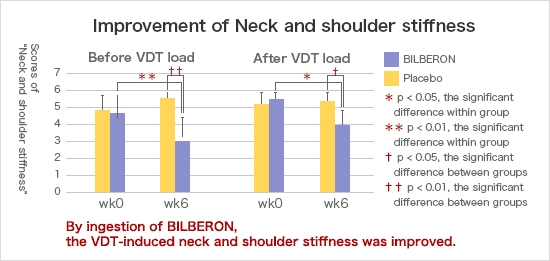
II. Improvement of accommodative function
Accommodative function was evaluated using TriIRIS, and the miosis frequency (MF) values (%) was calculated by using near point pupil diameter and far point pupil diameter (The higher of the value indicates the improvement of the accommodative function). The MF values of left eye, right eye, average of eyes and dominant eye were significantly increased after the ingestion of BILBERON in the test group, and the value of the dominant eye was significantly increased after 6-week ingestion period, compared to the placebo group. These results indicated improvement of accommodative function by the ingestion of BILBERON.
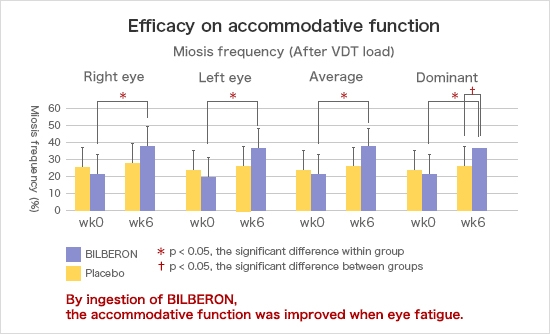
III. Reduction of eye fatigue sensation
Eye fatigue sensation was evaluated by a Likert scale questionnaire, which was performed before and after the VDT load at each examination day (A higher score indicated a higher severity of the symptom). As the results, after 6-week ingestion, eye fatigue sensation was significant decreased in the test product group compared to the placebo, indicating the reduction of eye fatigue sensation by ingestion of BILBERON.
In addition, the eye fatigue was also evaluated by flicker test, and no significant changes were observed in the test product group, indicating the accumulation of eye fatigue was relieved by ingestion of BILBERON.
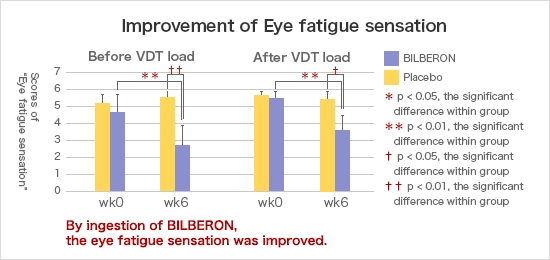
Eye fatigue-related symptoms improvement [2] 120 mg/day
(Source: Jpn Pharmacol Ther 2016 44 (12) 1773-1783)
In this human trial, 22 healthy Japanese volunteers with subjective eye fatigue induced by visual display terminal (VDT) work such as smartphones, computers etc. were recruited. The subjects were randomly divided into two group (n=11/group) and orally ingested either 120 mg/day BILBERON or placebo capsule for 6 weeks. VDT was loaded at the examination days of the before and after 6-week ingestion, and then eye dryness, accommodative function, and eye fatigue sensation were evaluated.
I. Improvement of accommodative function
In this study, the near point pupil diameter (NPD) was measured by TriIRIS and the variation of the NPD before and after the VDT load was used to evaluated the accommodative function (The lower of the value indicates the improvement of the accommodative function on the near pupil diameter). The results showed there were less values in the variation of NPD in left eye and average of eyes in the test product group, compared with the placebo group. These results indicated the ingestion of BILBERON improve the accommodative function while eye fatigue.

II. Reduction of eye fatigue sensation
Eye fatigue sensation was evaluated by a Likert scale questionnaire, which was performed before and after the VDT load at each examination day (A higher score indicated a higher severity of the symptom). As the results, after 6-week ingestion, eye fatigue sensation was significant decreased in the test product group compared to the placebo, indicating the reduction of eye fatigue sensation by ingestion of BILBERON.
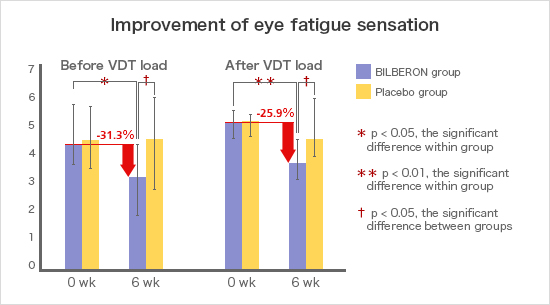
The eye fatigue was also evaluated by Flicker test※ (The larger of the value, the greater status of eye to identify the flashing light diode). After 6-week ingestion, the flicker values were significantly decreased in the placebo group, while no significant changes were observed in the test product group, indicating the accumulation of eye fatigue was relieved by ingestion of BILBERON.
※Flicker test
The flash frequency of emitted red light was changed gradually, then the frequency which subjects could identify the difference was recorded as flicker test value (the flicker test value by red light was used as an index of eye fatigue).

III. Improvement of eye dryness
Schirmer’s test was performed to inspect the secretion of tears by using Schirmer tear test strips. After 5 min, the length of wet strip was measured. After 6 weeks ingestion, the increase of the length of wet strip in BILBERON group was observed in each right eye, left and average of eyes. Moreover, after 6 week ingestion, the significant increase was observed in the right eye in BILBERON group compared with the placebo group. These results suggested that ingestion of BILBERON improve the eye dryness.
Bilberon is rich in anthocyanin
Anthocyanins are the principle active components of bilberry which is the raw material of Bilberon. Anthocyanins are glucosides that anthocyanidin, as aglycone, combined with sugar.
There are 15 kinds of bilberry anthocyanins that are rich in the glycosides of delphinidin and cyandin, both have a higher antioxidative activity. Also, compared with other blueberry, bilberry contains more than twice the anthocyanins.
Specification of Bilberon
| Product name | Item | Spec. value |
|---|---|---|
| Bilberon-25 | Anthocyanidins | Not less than 25.0% |
| Anthocyanins | Not less than 36.0% | |
| Free Anthocyanidins | Less than 5% | |
| Bilberon-7 | Anthocyanins | Not less than 2.0% |

- It is reported that Bilberry anthocyanin promotes the recomposition of “rhodopsin”, an intraretinal agent that feels the stimulation of light and sends that information to the brain.
Rhodopsin converts images that are projected onto the retina through a crystalline lens into an electrical signal and sends the information to brain, then this sensory protein is decomposed by light stimulus and recomposed in the dark; it repeats the decomposition and recomposition recycling.
However when the recomposition speed of rhodopsin becomes slower due to eyestrain or the volume has been reduced by aging, people can no longer maintain the necessary amount of rhodopsin, and as a result, it causes eyestrain and/or decline in vision. 
- Reactive oxygen, which would be massively generated in the body caused by ultraviolet radiation or stress, oxidizes body cells and tissues and lead to functional disorder of the body. It is said that reactive oxygen is the caused 90% of the time from lifestyle-related diseases, such as diabetes or arteriosclerosis.
It is known that anthocyanins has strong anti-oxidant power.
It has reliable qualities with an accurate reproduction of anthocyanin profiles.
Bilberon contains an accurately reproduced version of anthocyanin profiles of bilberry.
It is verified that, among various bilberry extracts available in the market, Bilberon has an extremely superb quality.

We have an extensive range of analytical equipment and with highly accurate analysis ability carried out by our experienced analysis technicians; we guarantee a high quality of Bilberon.
As for measuring the anthocyanin content of Bilberon, we conducted a precise quantitative analysis through molecular weight conversion after confirming the type of anthocyanins based on mass spectra and fragment information that was led by HPLC plus mass spectrometry.
Quality evaluation of on-market products
When we investigated the quality of other on-market bilberry extract products through HPLC plus mass spectrometry, we found that 10 out of 25 sample products showed anthocyanin profile that are clearly different from those of bilberry, confirmed those products have problems in quality.*
* The Japanese Society of Phamacognosy (The 54th Annual Conference, Nagoya, 2007)
Examples of Four on-market products’ anthocyanin profile
| Report of Result | Measured Value | Good / False | Anthocyanin profile | |
|---|---|---|---|---|
| Sample 1 | Anthocyanidins: 23.75-28.25% | 25.4% | Amount of of anthocyanidins (compound 16-20), the degradation product, were unusually high. | |
| Anthocyanins: No mention | 19.8% | |||
| Free Anthocyanidins<1% | 44.5% | |||
| Sample 2 | Anthocyanidins: 26.05% | 24.6% | Compound 21 and 22 were not bilberry anthocyanidins. | |
| Anthocyanins: No mention | 24.6% | |||
| Sample 3 | Anthocyanidins:25.21% | 25.2% | While compound 5 is also contained in bilberry, its amount was unnaturally too much. Compound 22 was not bilberry anthocyanin. | |
| Anthocyanins :36.30% | 23.7% | |||
| Sample 4 | Anthocyanidins: No mention | 4.5% | It was completely different from bilberry anthocyanin profile. | |
| Anthocyanins: No mention | 1.7% |
It only uses high quality bilberry fruits native to Northern Europe that have been guaranteed by the “Certificates of Origin”.
Bilberon uses only 100% high quality bilberry fruits, native to Scandinavia that have been guaranteed by the “Certificates of Origin”. Every year, we visit the production area and select only bilberry fruits that pass the requirements for all inspection items. These bilberry fruits are preserve by rapid freezing and are directly sent to Japan.


- Harvesting work
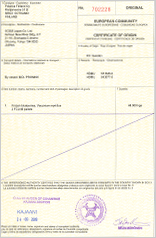
- Certificate of Origin
Initiatives toward Expert Testimony Technique Development to secure traceability.
To judge imported fruits and secure traceability, we have been developing expert testimony techniques on the gene level that identify the type of plants and their production area. So far, we have established a technique to identify bilberry(Myrtillus section)and blueberry (Cyanococcous section) at the gene level by using an expert testimony method, which is called the RAPD method, which examines the DNA that is extracted from fruits to research the phylogenetic relationships of various plants that belongs to genus Vaccininum1). We are going to conduct a more detailed expert testimony technique development aiming at securing the traceability of the production area in the future.
1) The Japanese Society of Phamacognosy (The 54th Annual Conference, Nagoya, 2007)
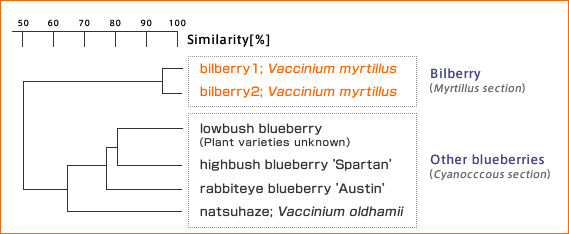
Features of Bilberry
Bilberry((Vaccinium myrtillus>)shrubs belongs to Myrtillus section, the genus Vaccinium of the family Ericaceae, is the wild blueberry plant that grows naturally mainly in Scandinavia. Extract from its pigment is widely used for supplements.
Among blueberries, only bilberry has had many studies on its functionalities. Bilberry extract has been authorized as a medicine for visual function improvement and as a capillary stabilizer in Europe and other regions.

Classification of blueberry
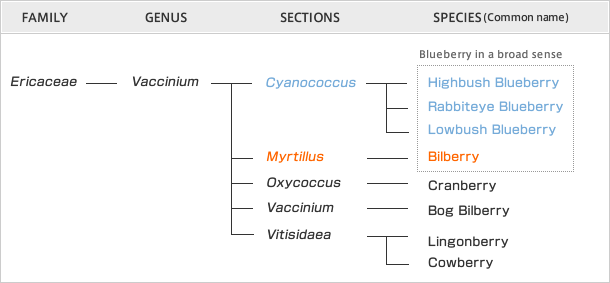
Comparison of various blueberries
| Name | Distribution | Soil Condition | Tree heights | Fruits | |
|---|---|---|---|---|---|
| Wild species | Bilberry (V.myrtillus) |
Scandinavia | Watery humus soil or peaty soil | 10~60cm | Small Dark purple till center of flesh |
| Lowbush Blueberry (V.angustifolium) (V.myrtilloides) |
Eastern Canada | Waste land | 15~40cm | Small Dark purple till center of flesh | |
| Agricultural species | Highbush Blueberry (V.corymbosum) |
Michigan New Jersey |
Sandy soil that is rich in organic matter. It is vulnerable to dryness. | 1.5-3.0 m | Big Rind is purple |
| Rabbiteye Blueberry (V.ashei) |
Georgia North Carolina | Compare with highbush, it has wider soil adoptability. | 1.5~3.0m | About middle Rind is purple or red |
Domestic production for safe and secure quality
We continue to persist in the domestic production of Bilberon. While many bilberry extract products in the market are produced overseas, Bilberon is made by integrated production in our own factory in Sakura city, Chiba prefecture.
GMP Approval
Bilberon-25 was officially approved by the Japan Institute for Health Food Standards (JIHFS) in July 2010 as a product that is made in accordance with GMP guideline of the Ministry of Health, Labour and Welfare.

※ This product is produced in a JIHFS GMP authorized factory. JIHFS GMP for Health Food conforms to the Health Food GMP guideline of the Ministry of Health, Labour and Welfare. GMP is an abbreviation for Good Manufacturing Practice.
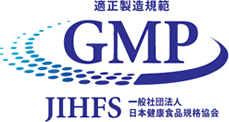
HALAL Authorization
Bilberon-25 has been authenticated as a HALAL food by the Japan Muslim Association in December 2011.


KOSHER Authorization
Bilberon-25 has been authenticated as a KOSHER food by the Jewish Community in Japan in February 2011.


Safety data of BILBERON
| Test | Result |
|---|---|
| Acute toxicity (Mice) |
LD50 ≧2000 mg/kg |
| Ames test | Negative |
| Subchronic toxicity (Rats) |
Twenty-eight-day Repeat Dose Oral Toxicity Test NOAEL 2000 mg/kg/day (1200 mg/day human) |
| Human trial | At 120 mg/day & 160 mg/day, no adverse events were observed for 6-week ingestion. Nakata et al., (2016); Liang et al., (2017) |
It complies with the system of “Food with Function Claims”
As a part of the whole nation’s initiative for disease prevention and health care aiming at realizing a society that “extends the healthy life expectancy of the Japanese people”, the system of “Food with Function Claims” was established in April 2015.
This system allows manufacturers to show consumers an easy-to-understand way about the health functions of food.
To be authorized as a functional food that conforms to the system of “Food with Function Claims”, it is required to submit to the Consumer Affairs Agency (CAA) a “scientific base mandated to describe functions of the foods on its label”. This means any company that wants to apply to the system, needs to review literature on the functionality of necessary ingredients as well as verify that its product contains an effective dose of the identified ingredients.
Tokiwa phytochemical Co., Ltd. offers materials corresponding to the system of “Food with Function Claims”: VENETRON®(Sleep quality improvement), BILBERON®(Focus accommodative function, eye fatigue), GINKGOLON(Cognitive function improvement), SIRTMAX®(Anti-hyperglycemia, anti-aging, in preparation).
History of our research activities on Bilberon
For more than 20 years, since we started Japan’s first production of bilberry extract in 1992, we have been pursuing the utmost quality of the product and also conducting basic researches on Bilberon




